
| Home |

|
PREFACE | PRIMEVAL | SPECIAL | GENERAL | CONCLUSION |
| Dictionary | Events | Aristotle | Galileo | Newton |
 Aristotle's Absolute Rest
Aristotle's Absolute Rest



 Galileo's Principle of Relativity
Galileo's Principle of Relativity

 |
|---|
| Galileo Galilei (1564-1642) |
Galileo challenged Aristotle's notion of "absolute rest".
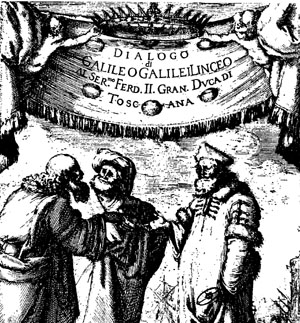
From his Dialogue Concerning the Two Chief World Systems, Galileo wrote:
...have the ship proceed with any speed you like, so long as the motion is uniform and not fluctuating this way and that. You will discover not the least change in all the effects named, nor could you tell from any of them whether the ship was moving or standing still.
Here is the full passage.
In other words, "the mechanical laws of physics are the same for every observer moving uniformly with constant speed in a straight line". Such an observer who "moves uniformly with constant speed in a straight line" (i.e., "moves with constant velocity") is a special type of observer: called an "Inertial" Observer. (From now on, we use "inertial" instead of "moves with constant velocity")
So, we can restate:
The mechanical laws of physics are the same for every inertial observer.
Galileo's Principle of Relativity
By observing the outcome of mechanical experiments,
one cannot distinguish a state of rest from a state of constant velocity.
Suppose that you are on an airplane. At 12:00, you leave your seat to talk to a friend a few rows in front of you. At 12:15, you return to your seat. You would probably say that: at 12:15, you were at the same point in space where you were at 12:00. However, what would a ground-based person claim? If the plane were going 600 mi/hr, that person would claim that: at 12:15, you were at a point in space (600*(15/60)=)150 miles away from where you were at 12:00.
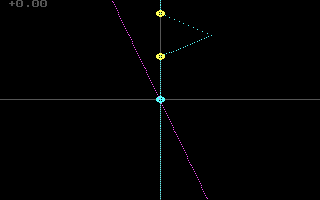 From your point of view in the plane.
From your point of view in the plane.
Your worldline is vertical. The other person
is slanted to left since he is receding from you (from your view).
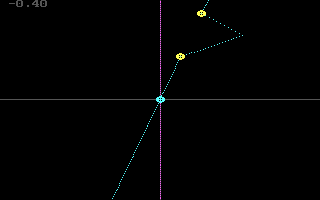 From the point of view of someone waiting at the airport.
From the point of view of someone waiting at the airport.
His worldline is vertical. To that person, your worldline is
slanted to the right since you are receding from him (from his view).
This is Galileo's Spacetime (seen edge on). Although it looks a little bit like Aristotle's Spacetime, it's different. Rather than it being a rigid stack of planes, it's "a stack of planes that are allowed to be slanted so as to change the tilt of the stack". Think of doing this with a deck of cards
The blue observer has his worldline vertical.
The red observer has his worldine tilted to the right.
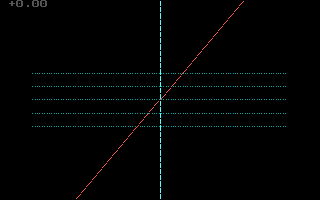
By allowing the deck to be slanted,
the red observer can make his worldline vertical.
The blue observer, as a result, has worldline tilted to the left.
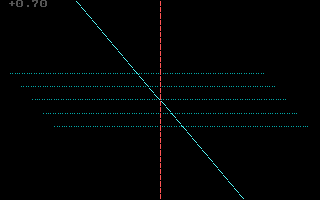
The following animation will show how the purple line, which is slanted to the right in this diagram, becomes a vertical line as a result of this operation. In the process, the yellow line, which is vertical in this diagram, gets slanted to the left. This operation is called a Galilean transformation.
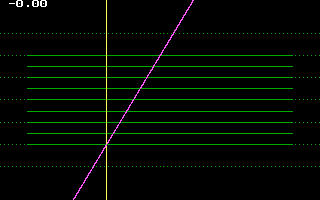 A Galilean Transformation
A Galilean Transformation
 (280 kb)
(280 kb)
 (24 kb)
(24 kb)
The Galilean Principle of Relativity abolished the universality of the notion of "an observer at rest". Recall that no mechanical experiment can ever distinguish "rest" from "uniform velocity". Thus, "absolute rest" has no universal meaning according to Galileo. The state of "being at rest" has been demoted from being a public, universal concept to being a private, personal concept.
Galilean Map Reading 201:
In the following spacetime diagrams, BLUE and RED are inertial observers. In the first three diagrams, two events on RED's worldline are of interest here.
How to recover "space" and "time" from "spacetime"
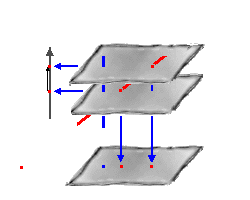
In this spacetime diagram, BLUE is at rest and RED is whizzing by with uniform velocity.
BLUE determines that these two events have a certain nonzero spatial separation.
(...to recover "space" from spacetime, BLUE casts shadows onto a horizontal plane along a direction parallel to his worldline.)
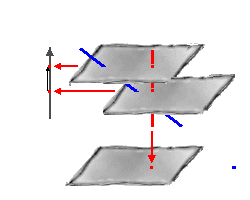
In this spacetime diagram, RED is at rest and BLUE is whizzing by (in the opposite direction).
RED however determines these same two events to be coincident in space.
(...since these two events lie on his worldline.)
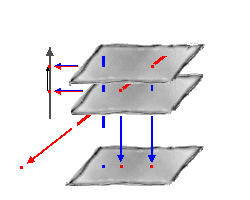
BLUE and
RED, however, determine the same "elapsed time" bewteen these two events
(..."elapsed-time" is a universal notion in Galileo's spacetime. In particular, "zero elapsed-time" or "simultaneity" is a universal notion in Galileo's spacetime.)
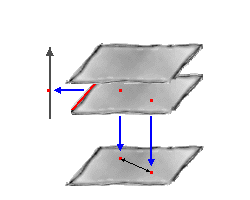
BLUE and
RED will determine that same "spatial separation" for "simultaneous" events.
(..."spatial separation of simultanous events" is a universal notion in Galileo's spacetime).Thus, "distance" or "spatial separation" between two events only makes (universal) sense when the events are simultaneous.
On a spacetime diagram, the worldlines of the inertial observers are non-horizontal straight lines. What Galileo's Principle of Relativity does is that it establishes a sort-of democracy among all inertial observers in the sense that each inertial observer could view the world from the vantage point where he is at rest.
How would an inertial observer describe himself from his vantage point? Well, for all times, our inertial observer is "at rest relative to himeself". In other words, his position does not change over time. Thus, on the diagram, he appears as a vertical line, slanting the horizontal planes, as necessary.
 A poetic interpretation of Galileo's Spacetime
A poetic interpretation of Galileo's SpacetimeIn Galileo's time, people all over the world, on land or sea, were reading about Aristotle's Prime Mover. After finishing the book, each sits up from his bed and looks around the room. Each person sees himself at rest and other things in his room moving about him. Suppose each person looks at the same mechanical system in his room, say, a standard-issue pendulum. Galileo realized that each person, whether at absolute rest or in steady straight-line motion, will see the same mechanical motion. Watching the pendulum does not reveal one's state of motion. Each person could declare themselves as being at absolute rest, like the Prime Mover. With news of this realization, there were people all over wanting to be the Prime Mover, and that each wanted to brand space with his own set of numbers. In response, Galileo quickly established a democracy among them. The labels seared into space by Aristotle's Prime Mover were removed, though the metersticks were left. The statue of the Prime Mover was defaced. But since the clock still worked well, vandals left that alone.
This is Galileo's Spacetime. To recover space, each observer counts off the number of metersticks in each direction to that point in space. To recover time, listen to the announcements of the Prime Mover's clock.
| Home |

|
PREFACE | PRIMEVAL | SPECIAL | GENERAL | CONCLUSION |
| Dictionary | Events | Aristotle | Galileo | Newton |